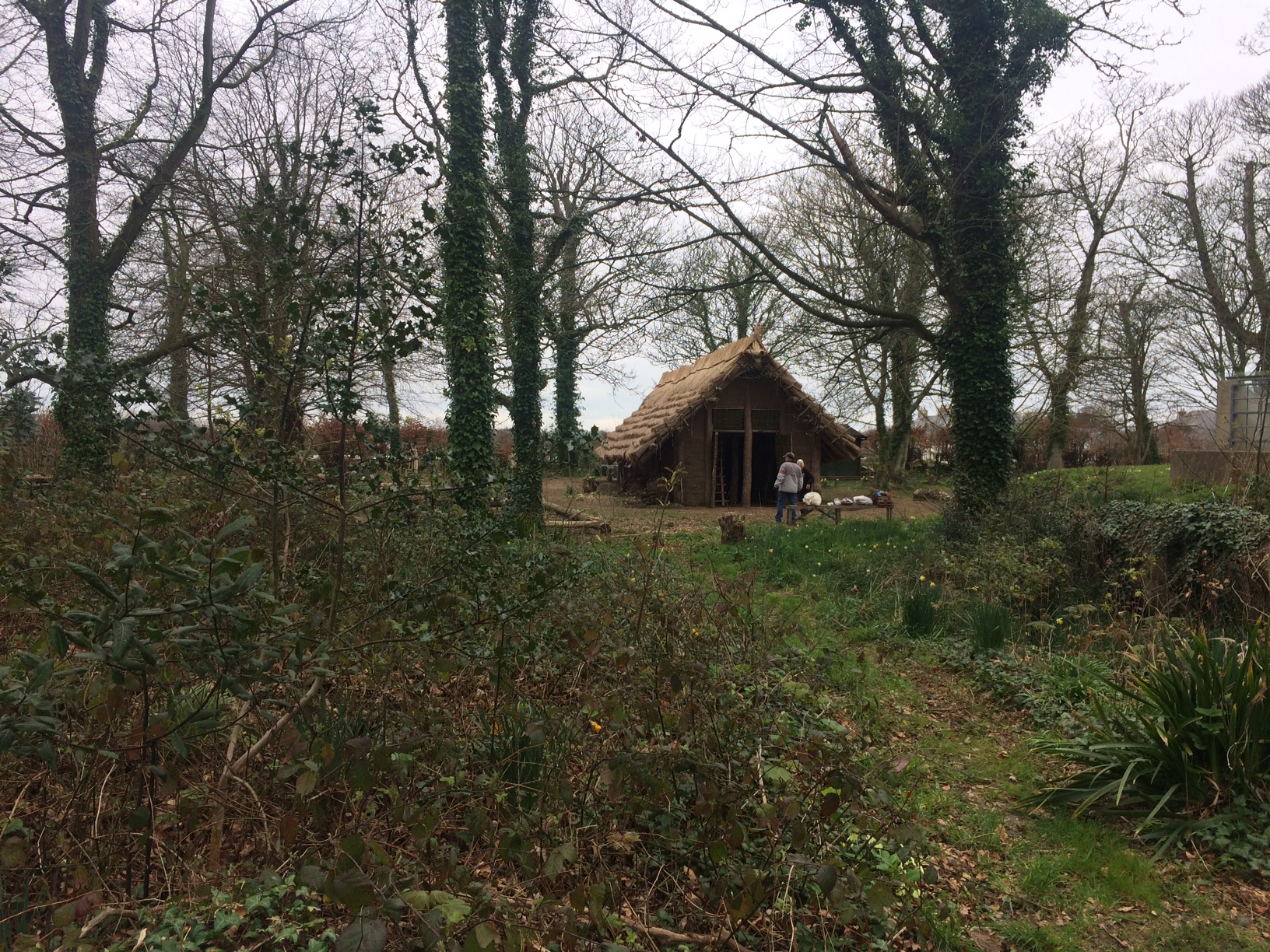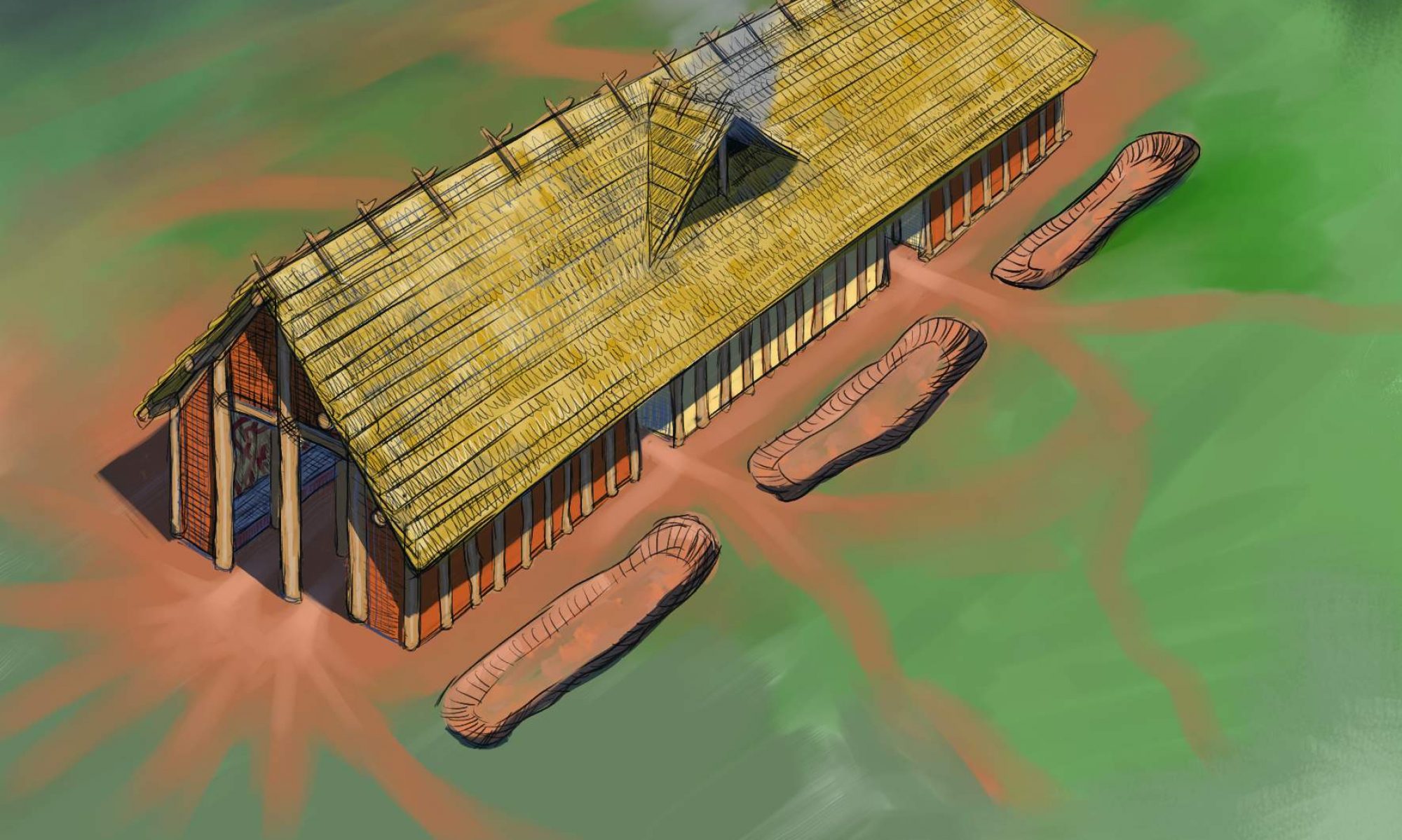Tuesday 29th January 2019
The final official project week has begun! After a break for Christmas, The team has reassembled for a final push on the longhouse doors. Work has continued while I was away and the building is looking amazing! Most of the daub is completed and some internal painting has started making a real difference to the panels and their finish.

Today we have discussed how the project can move on in terms of experiments….. …. The volunteers have a great approach to future work and are thinking of the many things they would like to achieve over the next few months and years. Any project needs this enthusiasm to really consolidate and improve what’s there. The discussion centred on how to record experiments and what to focus on.
What has become clear over the last two years is that, while I have been recording data such as measurements, timings and structural considerations, we have all been noticing experiential evidence that is difficult to quantify. In other words, we know how the building is made but we have recorded very little of how it FELT to make it, or the multitude of ideas and thoughts that various tasks and construction stages produced.
This is an area of interest for me after many projects over the years. We can look at the mechanical processes of construction, the efficiency of tools, the volume of materials used, the preferred method of construction compared to others, the effect on landscape, but our anecdotal evidence of how it felt, and looked, the aesthetics and personal stories and thoughts of our experience is still trapped in our heads!
There are many examples of this way of thinking. Last year, during a project at Stonehenge, I organised a bluestone sized piece of rock to be pulled and erected into place by the public over the course of a weekend. The stone weighed around 4 tonnes and we used between 70 and 140 people to move and lifted it into a hole in the chalk. What surprised me during that project were some aspects of the real world engineering required in wet and muddy conditions, but importantly, the number of people who came up to me afterwards to say how incredible it felt to be part of a large team all working successfully towards a common goal. It is this “evidence” we lack when considering the archaeological record, and yet it is exactly this personal story that is responsible for the construction of our past. The physical remains of buildings and monuments are only fingerprints of our emotional experiences, and although impossible to know exactly what ancient people felt, or the reasons why they did things, our modern perspective of similar tasks can only be helpful in trying to reach some understanding.
Another example comes from the many buildings I have designed and helped to build. Typically, when members of the public visit finished buildings, they have a range of reactions and emotions. A common one is they feel some kind of “vibe” or a feeling they cannot explain. For me, and I presume, many other builders of those same structures, I feel no “vibe” at all, but the building does represent a group of memories based mainly on people. I have technical memories yes, but the majority of what I experience are the memories of the conversations I had with hard working people. the humour, the ideas, the hardships and the relationships. The building is a monument to a certain group of people and their associated memories. A tie beam in a Viking Longhouse is actually a physical reflection of the 5 people who hewed it and the 30 that lifted it into position, and their names and personalities are etched into the timber through the marks their tools left behind and in its manhandled position in the building.

Wednesday 30th January 2019
The weather has finally caught up with us on this project! Yesterday we all got soaked and cold with the persistent heavy and cold rain. Today we have had prolonged bouts of hail which fell to such a degree that it looked like snow!
Still, we can’t complain after our incredible luck over the last two years!
Today work has continued (despite the freezing weather) on the willow doors. From the beginning, these doors have been seen as midterm constructions until more substantial doors can be made from planks. That said, there is certainly nothing wrong with willow doors. They can be covered with leather to make weatherproof closures and are light and quick to build.
Danny has finished the weaving on door one and is now working on fitting it to its opening.
Teams are rapidly progressing with the remaining doors and it looks like they will all be in place this week.

Thursday 31st January 2019
The mud is slightly less today and the weather is dry, for the moment!
The building has changed again, with working doors appearing in doorways and re-adjusting our consideration of the building yet again.
The nearly completed structure is crying out for some internal warmth and light from a regular and well managed fire. A real wood fire is an essential and integral part of any traditional structure and serves a range of purposes (obviously heat and light for daily life) including the less obvious task of maintaining and preserving the organic raw materials used in its construction.
Firstly, a fire obviously produces regular levels of heat that dries any accumulated dampness in the thatched roof, walls and floors. This regular drying discourages the development of fungal spores and prevents organic materials from rotting.
Secondly, the smoke that is produced by a well maintained fire percolates the structure, its smaller wooden elements such as battens an organic ties and especially the thatch. This regular smoking prohibits the infestation of the building by rodents and boring insects and significantly increases the longevity of the building’s life and crucially, reducing the need for serious structural repair.
Fires in traditional buildings can be safely managed with simple rules and procedures, and their educational value cannot be underestimated when considering how schools and the public interact with a building designed to interpret the lives of people in the past.
My experience of building and using traditional structures for educational and experimental purposes has confirmed the need for small but regular fires to get the best out of a structure on every level.


Friday 1st February 2019
The changeable weather heralds the official end of my involvement in this project.
What a fantastic experience its been! The building has taken on a life of its own due to the incredible volunteers who have not only built it, but who are working towards refining and improving it in the future.
This team, few of whom had met each other before this project began, have gone from very little or no experience with buildings and projects like these, to being a well rounded, experienced, skilful, confident and passionate bunch of experts! My regular involvement stops at this point, but I have every confidence in their abilities to use evidence, material knowledge and experimental questions to really bring the house alive for visitors.
Looking back over the last 28 months, it is incredible to see how far this project has come. The building, a beautiful thing in its own right, is nevertheless, a physical reminder to us all of the people who built it. It is an impressive example of people coming together for a common goal.
Today, Iris hit the nail on the head when she said “Without “Tribe”, this couldn’t have happened”, and the point is well made. It has taken that communal spirit and enthusiasm to make it a success. The learning curves involved in this project have been equally impressive and very steep! Each volunteer has learnt a multitude of skills and understood material properties, and they have practised those skills as the building progressed until they are now expert. Importantly, and this should not be forgotten, although each new learning phase has been exciting and engaging, what has actually finished each phase and the building as a whole is sheer effort and thousands of hours of sweat and toil.

We have learned many things about the building and its construction and over the next few months I will compile all of my data and thoughts and let you all know what those things are. Have we learned what it was like to build in the Neolithic? Well, obviously we are no longer neolithic people, without their inherited construction traditions, or their innate tool efficiency based on a life that only knew stone and bone tool technologies. But all of us have learnt something of the camaraderie and physical requirements, not to mention motivations and problem solving that a project like this requires. We have made friendships that were unexpected and above all, we have a fuller understanding of the capabilities of our Neolithic ancestors. It has been a privilege for me to witness a group of people come together and work their socks off while genuinely appreciating the sophistication and knowledge of those Neolithic builders.

I am excited to see what this remarkable group of people bring to the building over the next few years and to see how their skills and enthusiasm will flourish in the house they have built.

I must give huge thanks to the staff at Jersey Heritage who have been nothing but supportive throughout this project. They have really understood the relevance and importance of a project like this in a modern world that increasingly undervalues traditional skills and ancient practice. I know they are equally proud of their fantastic volunteers and their amazing achievements during this project and are supporting their future work and goals in the building. Future plans include exciting developments such as furniture building, a Neolithic garden, some beautiful plank doors, Neolithic pottery, fishing equipment, and bow making. An exciting continuation of an awesome project!


